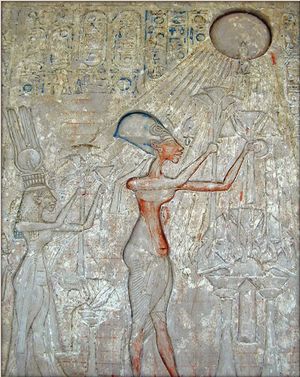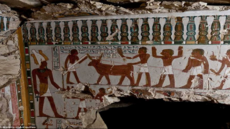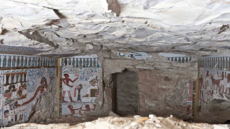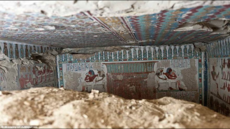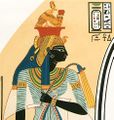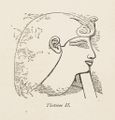الأسرة المصرية الثامنة عشر
| ||||||||||||||||||||||||||||||
| ||||||||||||||||||||||||||||||
الأسرة المصرية الثامنة عشر[1] (ح. 1543–1292 ق.م.)، هي أسرة فرعونية قديمة حكمت مصر في الفترة (1550 ق.م. - 1292 ق.م.)، في الدولة الحديثة بمصر القديمة. وتعتبر من أشهر وأقوى الأسرة المصرية على الإطلاق. امتدت الأسرة الثامنة عشرة في الفترة من 1549/1550 حتى 1292 ق.م. وتُعرف هذه الأسرة أيضاً بالأسرة التحتمسية نسبةً إلى أربعة من الفراعنة الذين حملوا اسم تحتمس.
ضمت الأسرة الثامنة عشر مجموعة من أشهر فراعنة مصر، ومن بينهم توت عنخ أمون، الذي اكتشف مقبرته هوارد كارتر عام 1922. ومن الفراعنة البارزين الآخرين في هذه الأسرة: حتشپسوت (ح. 1479 ق.م – 1458 ق.م)، وهي الحاكمة المصرية الأطول حكماً من أسرة محلية، وأخناتون (ح. 1353–1336 ق.م)، المعروف "بالفرعون المهرطق"، مع زوجته الملكية العظمى نفرتيتي.
تتميّز الأسرة الثامنة عشرة بين الأسر المصرية القديمة بوجود امرأتين حكمتا كفرعون منفرد: حتشپسوت، التي تُعد من أكثر حكام مصر القديمة ابتكاراً، ونفرنفرآتون، التي تُعرّف عادة بنفرتيتي الشهيرة.[2]
التاريخ
أوائل عهد الأسرة
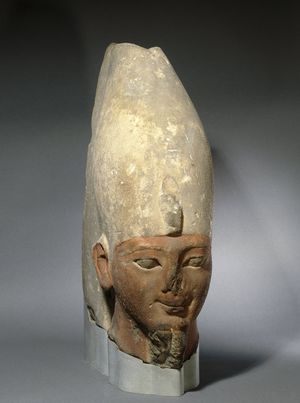
تأسست الأسرة الثامنة عشرة على يد أحمس الأول، شقيق أو نجل كامس، آخر حكام الأسرة 17. أكمل أحمس الحملة لطرد حكام الهكسوس. وتُعد فترة حكمه بمثابة نهاية للفترة الانتقالية الثانية وبداية عصر الدولة الحديثة. خلفه في الحكم نجله أمنحوتپ الأول، الذي كانت فترة حكمه هادئة نسبياً.[3]
من المحتمل أن أمنحوتپ الأول لم يترك وريثاً ذكراً، ويبدو أن الفرعون التالي، تحتمس الأول، كان مرتبطاً بالعائلة المالكة من خلال الزواج. وخلال فترة حكمه، بلغت حدود إمبراطورية مصر أقصى اتساع لها، حيث امتدت شمالاً إلى كركميش على نهر الفرات، وجنوباً إلى كورجس، متجاوزة شلال النيل الرابع. خَلَف تحتمس الأول في الحكم تحتمس الثاني وزوجته الملكة حتشپسوت، وهي ابنة تحتمس الأول. وبعد وفاة زوجها، وخلال فترة وصايتها على ابن زوجها القاصر (الذي أصبح لاحقاً فرعوناً باسم تحتمس الثالث)، أصبحت حتشپسوت فرعوناً شرعيًا بنفسها، وحكمت لأكثر من عشرين عاماً.
تحتمس الثالث، الذي عُرِف بأنه أعظم فرعون عسكريّ على الإطلاق، تمتع بفترةِ حكم طويلة بعد أن تولى العرشَ. وفي أواخرِ عمرِه أقامَ وصاية مشتركة ثانية مع نجله أمنحوتپ الثاني. وخَلَفَ أمنحوتپ الثانيَ في الحكمِ تحتمس الرابع، وتلاهُ نجله أمنحوتپ الثالث، الذي تُعَد فترة حكمِه ذروة لهذه الأسرةِ. وقد نفّذ أمنحوتپ الثالث برامجَ بناء واسعة النطاقِ لا يقارَن حجمُها إلا بما أُنجِز في عهدِ رمسيس الثاني صاحب الحكم الأطولِ في الأسرةِ التاسعةِ عشرةِ.[4]
أخناتون، فترة العمارنة، وتوت عنج أمون

| |
ربما تقاسم أمنحوتپ الثالث العرش مع نجله أمنحوتپ الرابع لمدة تصل إلى اثني عشر عاماً. هناك جدل واسع النطاق حول هذا التشارك المُقترح في الحكم، إذ يرى خبراء مختلفون أنه كان هناك تقاسم طويل الأمد، أو قصير الأمد، أو حتى عدم تقاسم الحكم على الإطلاق.
في السنة الخامسة من حكمه، غيّر أمنحوتپ الرابع اسمه إلى أخناتون (ꜣḫ-n-jtn، وتعني "آمون يرضى" ونقل عاصمته إلى تل العمارنة، التي أطلق عليها اسم أختاتون. في عهد أخناتون، أصبح آتون (jtn، قرص الشمس) الإله الأول والأبرز، وفي النهاية أصبح يُعتبر الإله الوحيد.[5] لا يزال الجدل محتدماً في الأوساط الأكاديمية حول ما إذا كان هذا يُمثل توحيداً حقيقياً. يُشير البعض إلى أن أخناتون أسس توحيداً، بينما يُشير آخرون إلى أنه قمع عبادة الشمس سائدة بتأكيده على عبادة أخرى، بينما لم يتخلى تماماً عن العديد من الآلهة التقليدية الأخرى.
اعتبر المصريون اللاحقون "فترة العمارنة" هذه انحرافاً مؤسفاً. الأحداث التي تلت وفاة أخناتون غير واضحة. يُعرف اسما سمنخ كا رع ونفرنفروآتون، لكن مكانتهما ودورهما النسبي في التاريخ لا يزالان محل جدل كبير؛ فمن المرجح أن نفرنفروآتون كانت الزوجة الملكية العظمى لأختاتون، والاسم الملكي لنفرتيتي كفرعون. اعتلى توت عنخ أمون العرش في النهاية، لكنه توفي شاباً.[6]
آي وحور محب
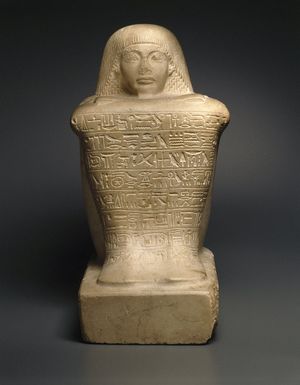
كان آخر اثنين من أفراد الأسرة الثامنة عشرة — آي وحورمحب — من كبار المسؤولين في البلاط الملكي قبل أن يصبحا فرعونين، على الرغم من أن آي قد يكون خال أخناتون، إذ يُعتقد أنه ينحدر من يويا وتويا كذلك.
قد يكون[آي قد تزوّج من عنخ إسن آمون، الزوجة الملكية العظمى الأرملة والأخت الصغرى غير الشقيقة لتوت عنخ أمون، من أجل الوصول إلى السلطة؛ ولم تعش طويلاً بعد ذلك. ثم تزوج آي من تاي، التي كانت في الأصل مرضعة نفرتيتي.
كانت فترة حكم آي قصيرة. أما خليفته فكان حورمحب، وهو جنرال في عهد توت عنخ أمون، وربما كان الفرعون الذي لم ينجب ينوي أن يجعله خلفاً له.[6] قد يكون حورمحب قد استولى على العرش من آي عبر انقلاب.
توفي حورمحب دون أن يترك خلفاً من نسله، بعد أن عين خليفته، رمسيس الأول، الذي اعتلى العرش عام 1292 ق.م، وكان أول فرعون في الأسرة التاسعة عشرة.
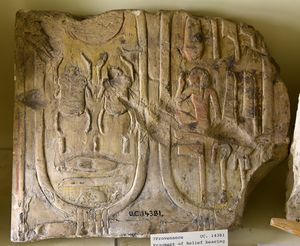
يعرض المثال أعلاه رجلاً يُدعى آي، بلغ مناصب دينية رفيعة، منها نبي آمون الثاني وكبير كهنة الإلهة موت في طيبة. وقد ازدهرت مسيرته المهنية خلال عهد توت عنخ أمون، وهي الفترة التي صُنعت فيها التمثال. وتُعد الخرطوشات الخاصة بالملك آي، خليفة توت عنخ أمون، الظاهرة على التمثال، محاولة من أحد الحرفيين "لتحديث" المنحوتة.[7]
التأريخ
تشير نتائج التأريخ بالكربون المشع إلى أن الأسرة الثامنة عشرة ربما بدأت قبل التاريخ التقليدي لعام 1550 ق.م. بعدة سنوات. يتراوح تاريخ بدايتها وفقًا للكربون المشع بين 1570 و1544 ق.م، ويقع متوسط هذا النطاق عند عام 1557 ق.م.[8]
فراعنة الأسرة
حكم فراعنة الأسرة الثامن عشر لحوالي مائتين وخمسين عاماً (1550-1298 ق.م.).[9] دفن العديد من الفراعنة في وادي الملوك في طيبة (تعين بحرفي KV).[10] كما أن العديد الزيجات الدبلوماسية للمملكة الجديد. غالبا ما تذكر زيجات بنات الملوك الأجانب فقط في النصوص المسمارية والتي لا تعرف من مصادر أخرى. كانت أن الزيجات على الأرجح وسيلة لتوتيض العلاقات الجيدة بين هذه الدول.[11]
| الفرعون | اسم-حورس | الحكم (ق.م.) | الدفه | القرين |
|---|---|---|---|---|
| أحمس الأول | Nebpehtire | 1549–1524 ق.م. | أحمس نفرتاري أحمس حنوت تمحو أحمس سات كاموس | |
| أمنحوتپ الأول | Djeserkare | 1524–1503 ق.م. | KV39? أو المقبرة ANB؟ | أحمس-مريت أمون |
| تحتمس الأول | Akheperkare | 1503–1493 ق.م. | KV20، KV38 | أحمس موت نوفرت |
| تحتمس الثاني | Akheperenre | 1493–1479 ق.م. | KV42? | حتشبسوت إيسـِت |
| حتشبسوت | Maatkare | 1479–1458 ق.م. | KV20 | تحتمس الثاني |
| تحتمس الثالث | Menkheper(en)re | 1479–1425 ق.م. | KV34 | ساتياح مريترع-حتشپسوت نبتو منوي، مرتي، منحت |
| أمنحوتپ الثاني | Akheperure | 1425–1398 ق.م. | KV35 | تيعا |
| تحتمس الرابع | Menkheperure | 1398–1388 ق.م. | KV43 | نفرتاري يعرت موت إم ويا ابنة أرتاتاما الأول من ميتاني |
| أمنحوتپ الثالث | Nebmaatre | 1388–1350 ق.م. | KV22 | تييه گيلوخيپا من ميتاني تدوخيپا من ميتاني ست آمون إست ابنة كوريگلزو الأول من بابل.[11] ابنة كادشمان-إنليل الأول من بابل.[11] ابنة ترهوندارادو من أرزاوا.[11] ابنة حاكمة آميا[11] |
| أمنحوتپ الرابع/أخناتون | Neferkepherure-Waenre | 1351–1334 ق.م. | مقبرة أخناتن الملكية | نفرتيتي كيا تدوخيپا من ميتاني ابنة شاتيا، حاكم إنيشاسي[11] ميريت أتون? مكت أتون? غنخ إسن أمون ابنة بورنا-بورياش الثاني، ملك بابل [11] |
| سمنخ كا رع | Ankhkheperure | 1335–1334 ق.م. | مريت أتون | |
| نفرنفروأتون | Ankhkheperure | 1334–1332 ق.م. | نفرتيتي? أخناتون؟ | |
| توت عنخ أمون | Nebkheperure | 1332–1323 ق.م. | KV62 | غنه إسن أمون |
| آي | خبرخبرو رع آي | 1323–1319 ق.م. | KV23 | غنخ إسن أمون تي |
| حور محب | Djeserkheperure-Setepenre | 1319–1292 ق.م. | KV57 | موت نجمت أمنيا |
خط زمني

اكتشافات 2015
في مارس 2015، أعلنت وزارة الآثار المصرية، عن اكتشاف مقبرتين قديمتين تابعتين لأمنحتب، حارس معبد الإله آمون، في جنوب مدينة الأقصر.[12] وقالت الوزارة إن المقبرتين وجدتا بالقرب من جنوب مدينة الأقصر، وتعودان إلى عصر الدولة الحديثة من عهد الأسرة الفرعونية 18. ووزعت الوزارة صورا رائعة تظهر المقبرتين وعلى جانبيهما لوحات بألوان خضراء وبُنية مذهلة، مع كتابات هيروغليفية على الجداريات تصور الاحتفالات والأنشطة اليومية للمصريين القدماء، وعلى الرغم من مضي كل هذه السنوات الطوال، إلا أن الألوان والصور حافظت على روعتها ورونقها بشكل مدهش.
ويبدو أن المقبرتين قد نهبتا في وقت ما، وأن التوابيت التي كانت تحتوي على المومياوات والمرصعة بالجواهر فُقدت نتيجة لأعمال السلب والنهب للمقابر الفرعونية منذ قديم الزمان. وتحتوي المقبرتين على العديد من المشاهد زاهية الألوان تمثل صاحب المقبرة وزوجته أمام مائدة القرابين، ومشاهد تصور إلهة تعالج طفلا ملكيا، وكذلك مشاهد من الحياة اليومية. وتم اكتشاف المقبرة الأولى يوم 2 مارس، واكتشفت الثانية يوم 10 مارس، ويعتقد أن المقبرة الثانية تعود إلى "سا- موت" وزوجته، "تا- خيت"، أما المقبرة الأولى فيعتقد أنها لوالد "سا- موت" أمنحتب.
معرض الصور
Sketch from temple relief of Thutmose II. Considered a weak ruler, he was married to his sister Hatshepsut. He named Thutmose III, his son as successor to prevent Hatshepsut from gaining the throne. They had a daughter, Neferure.
Thutmosis III, a military man and member of the Thutmosid royal line is commonly called the "Napoleon of Egypt". His conquests of the Levant brought Egypt's territories and influence to its greatest extent.
Queen Nefertiti the daughter of Ay, married Akhenaten. Her role in daily life at the court soon extended from Great Royal Wife to that of a co-regent. It is also possible that she may have ruled Egypt in her own right as pharaoh, Neferneferuaten.
Queen Meritaten, was the oldest daughter of Akhenaten and Nefertiti. She was the wife of Smenkhkare. She also may have ruled Egypt in her own right as pharaoh and is one the possible candidates of being the pharaoh, Neferneferuaten.
Neferneferure and Neferneferuaten Tasherit. Shown here as children, they were two of six daughters born to Akhenaten and Nefertiti. It is possible that Neferneferuaten Tasherit was the one who may have been her father's co-regent and may have ruled as the female pharaoh, Neferneferuaten.
Smenkhkare, was a co-regent of Akhenaten who ruled after his death. It was believed that Smenkhkare was a male guise of Nefertiti, however, it is accepted that Smenkhkare was a male. He took Meritaten, Queen Nefertiti's daughter as his wife.
Tutankhamun, formerly Tutankhaten, was Akhenaten's son. As pharaoh, he instigated policies to restore Egypt to its old religion and moved the capital away from Akhetaten.
Ay served as vizier to Akhenaten, and Tutankhamun. He was the father of Nefertiti. After the death of Tutankhamun, Ay lay a claim to the throne by burying him and marrying his granddaughter Ankhesenamun.
After the death of Ay, Horemheb assumed the throne. A commoner, he had served as vizier to both Tutankhamun and Ay. Horemheb instigated a policy of damnatio memoriae, against everyone associated with the Amarna period. He was married to Nefertiti's sister, Mutnodjmet, who died in child birth. With no heir, he appointed his own vizier, Paramessu as his successor.
تييه was the daughter of the visizer, Yuya. She married Amenhotep III, and became his principal wife. Her knowledge of government helped her gain power in her position and she was soon running affairs of state and foreign affairs for her husband, Amenhotep III and later her son, Akhenaten. She is also Tutankhamun's grandmother.
انظر أيضاً
المصادر
- ^ Kuhrt 1995: 186
- ^ Daniel Molinari (2014-09-16), Egypts Lost Queens, https://www.youtube.com/watch?v=nmFM-rPerL4, retrieved on 2017-11-14
- ^ Aidan Dodson, Dyan Hilton: pg 122
- ^ Aidan Dodson, Dyan Hilton: pg 130
- ^ Dodson, Aidan; Hilton, Dyan (2010). The Complete Royal Families of Ancient Egypt. Thames & Hudson. p. 142. ISBN 978-0-500-28857-3.
- ^ أ ب Dodson, Aidan; Hilton, Dyan (2010). The Complete Royal Families of Ancient Egypt. Thames & Hudson. p. 143. ISBN 978-0-500-28857-3.
- ^ "Block Statue of Ay". brooklynmuseum.org. Retrieved 17 June 2014.
- ^ Christopher Bronk Ramsey et al., Radiocarbon-Based Chronology for Dynastic Egypt, Science 18 June 2010: Vol. 328. no. 5985, pp. 1554–1557.
- ^ Aidan Dodson, Dyan Hilton: The Complete Royal Families of Ancient Egypt. The American University in Cairo Press, London 2004
- ^ Sites in the Valley of the Kings
- ^ أ ب ت ث ج ح خ Grajetzki, Ancient Egyptian Queens: A Hieroglyphic Dictionary, Golden House Publications, London, 2005, ISBN 978-0954721893
- ^ "بالصور.. اكتشاف مقبرتين فرعونيتين من الأسرة الـ 18 بجداريات ذات ألوان مذهلة". روسيا اليوم. 2015-03-17. Retrieved 2015-03-18.
المراجع
- Kuhrt, Amélie (1995). The Ancient Near East: c. 3000–330 BC. London: Routledge. ISBN 9780415013536.
وصلات خارجية
- Hatshepsut: from Queen to Pharaoh, an exhibition catalog from The Metropolitan Museum of Art (fully available online as PDF)

